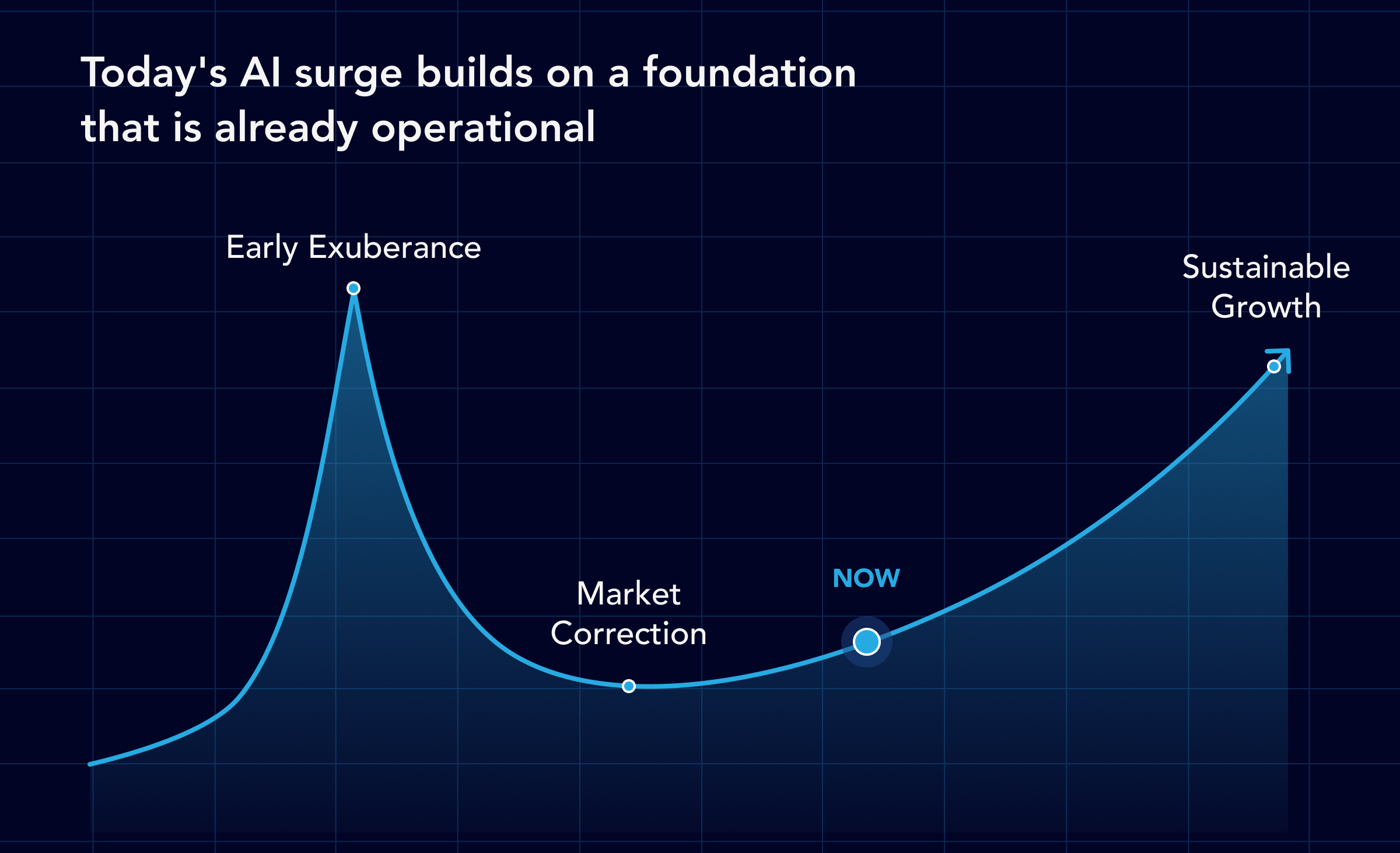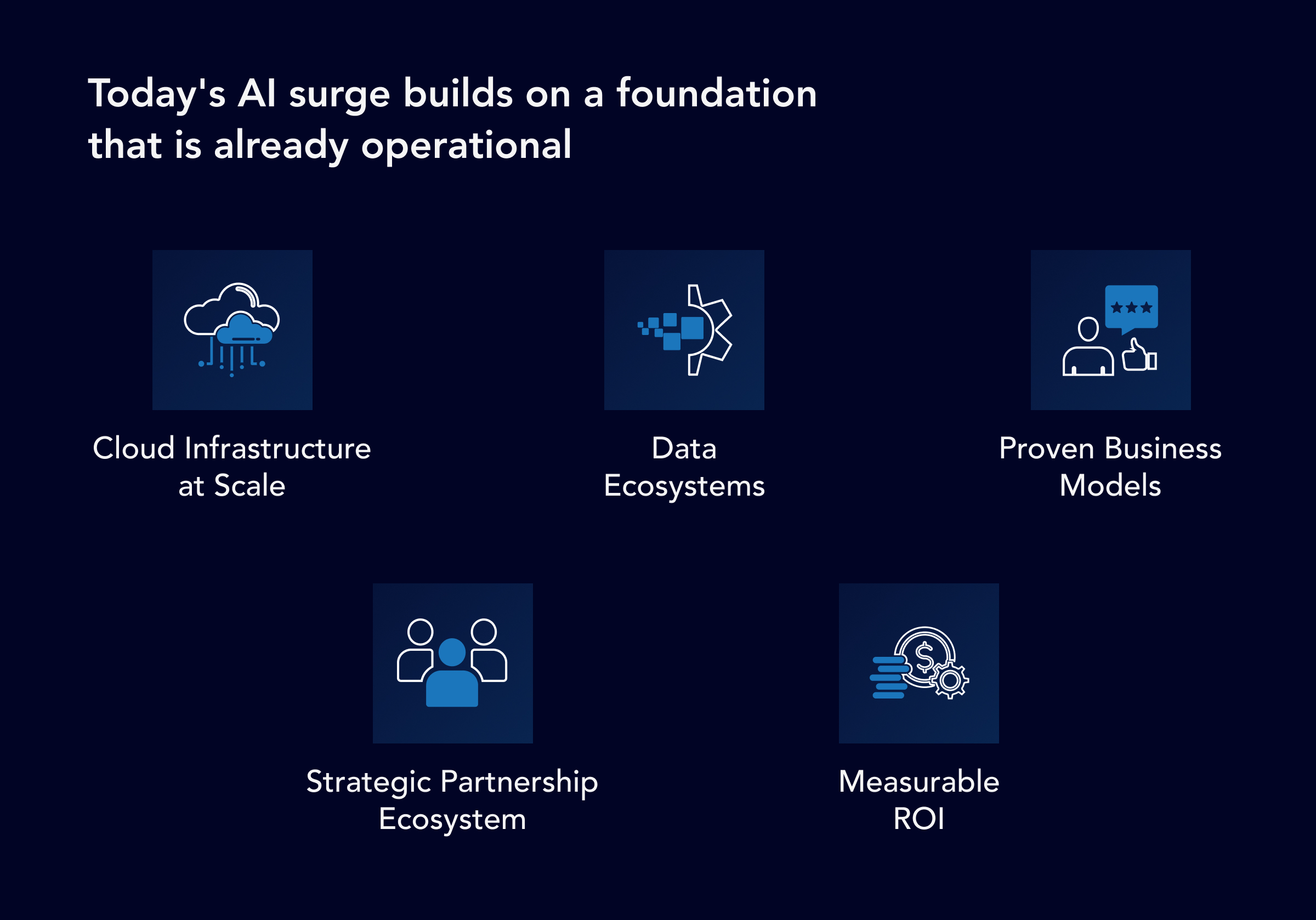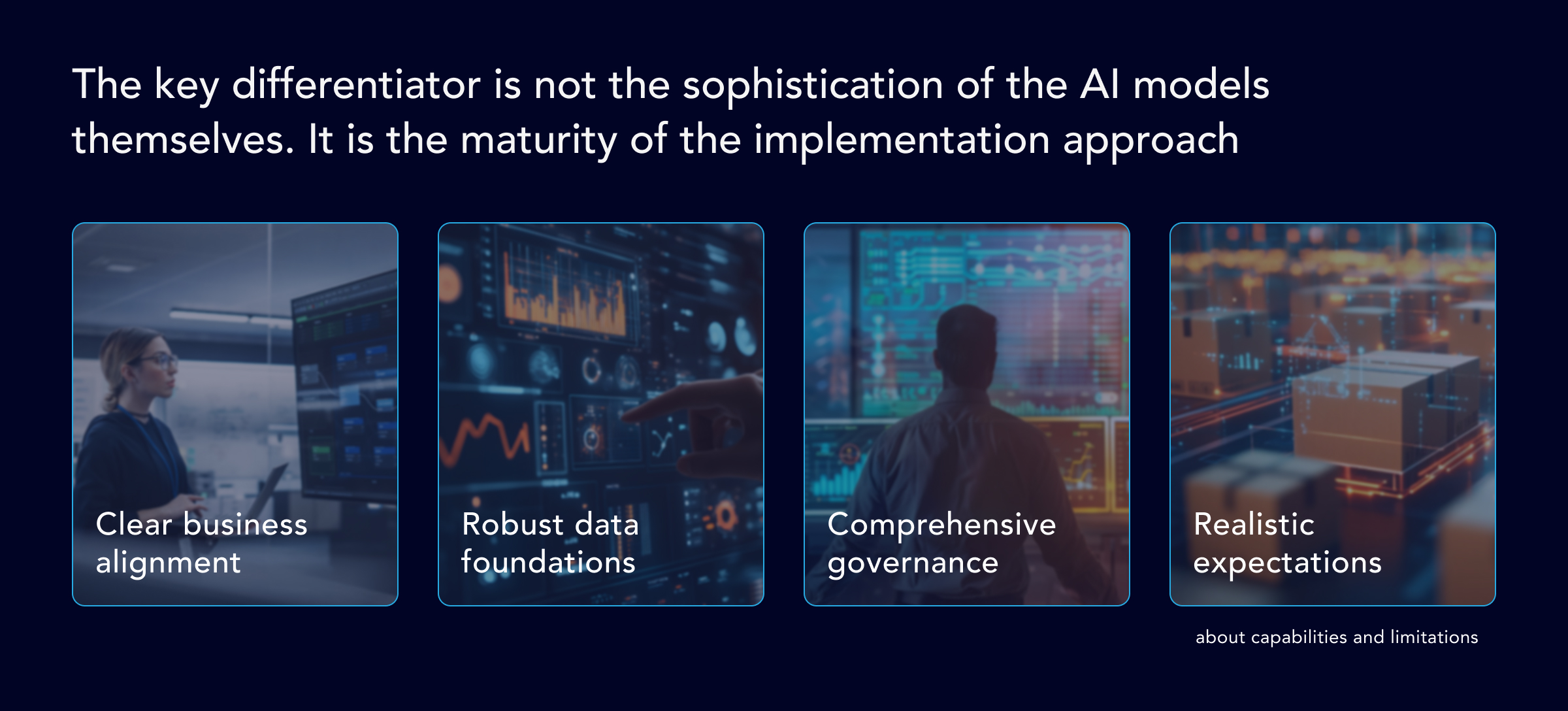
Back





Every major technology wave begins with exuberance. Today's build up in AI valuations has many recalling the dot com bubble of the late 1990s, and they're not wrong to see parallels. But beneath the market hype lies something fundamentally different. In the 1990s, the internet was an idea racing ahead of infrastructure. Today, AI builds on a foundation of cloud, data, and enterprise scale computing that's already in place. The technology is real, and it's producing measurable value, even if not every company claiming to be "AI driven" has the substance to back it up.
We're in the classic "hype to utility" transition: speculation at the edges, genuine transformation at the core. Some organizations will chase headlines; others will build the capabilities, data strategies, and governance that turn AI into lasting competitive advantage. For leaders, the greatest risk is no longer over adoption, it's strategic inertia. The cost of waiting to "get it perfect" now exceeds the cost of learning by doing. False starts are tuition; inaction is decay. Those who treat AI as a business capability, not a side project or experiment, will shape the next decade of enterprise performance.
Central banks are sounding alarms about AI market overvaluation. Analysts invoke the spectre of the dot-com crash. Tech investors brace for a correction. Even OpenAI's CEO acknowledges bubble conditions.
And they're not wrong to be cautious.
But as a Chief Revenue Officer navigating the intersection of market dynamics and operational reality, I've learned that taking calculated risks shouldn't translate into stalled decision making. As the "AI bubble" narrative gains momentum, I'm watching enterprise leaders across industries face a critical decision: double down on strategic AI initiatives or pull back and wait for clarity. The stakes could not be higher, and the choice is anything but obvious.
From where I sit, the cost of getting this wrong, in either direction, is measured in competitive position, market share, and organizational relevance. That's precisely why I'm sharing these findings through this insight paper.
Every major technology wave begins with exuberance. The comparison to the dot-com bubble is not unwarranted. Tech companies are projected to invest approximately $400 billion in AI infrastructure this year alone. Market concentration among leading AI companies mirrors patterns that preceded previous corrections.
The European Central Bank has flagged concerns about market concentration risks, noting that a small number of companies could extract most of AI's created value. The Bank for International Settlements has published frameworks specifically addressing AI governance risks in financial institutions, recognizing both the opportunities and the complex risk management challenges.
Yet beneath the market speculation lies something fundamentally different from the late 1990s .

In the 1990s, the internet was an idea racing ahead of infrastructure. Promises outpaced capability. Capital flowed to concepts without substance, to business plans sketched on napkins, to companies with no path to profitability.

Today's AI surge builds on a foundation that is already operational:
The technology is real. The value is measurable. The infrastructure is deployed.
History teaches us that technology waves do produce winners and losers. Think back to when the automobile was new. Many tried to enter during the hype phase. Far fewer survived. But those who did redefined mobile society and created industries that lasted generations.
There will be fallout. Not every company claiming to be "AI-driven" has the substance to back it up. Market corrections will come. But this inevitable consolidation should not deter enterprises with genuine transformation opportunities.
The survivors share common characteristics:
We are in the classic "hype-to-utility" transition.
Nearly three-quarters of organizations have adopted AI for at least one business function, with around two-thirds using generative AI. However, only 8% report using AI for five or more business functions, suggesting we remain in the early stages of integration.
This pattern is normal and healthy. Speculation exists at the edges while genuine transformation takes root at the core. Some organizations will chase headlines and deploy AI for its own sake. Others will methodically build the capabilities, data strategies, and governance frameworks that turn AI into lasting competitive advantage.
The question is not whether your organization will be affected by market corrections or industry consolidation. The question is whether you will have built real capabilities when the dust settles.
For enterprise leaders, the risk equation has fundamentally shifted. Five years ago, the primary danger was premature adoption of immature technology. Today, the mathematics look different.

Central banks and regulators are right to sound notes of caution. The BIS has published comprehensive governance frameworks recognizing that AI adoption entails complex risk management challenges, from data security to model "hallucinations" to reputational risks.

But caution should inspire thoughtfulness, not paralysis. The path forward combines healthy skepticism with proactive capability building:
The progression from experimental AI to operational business capability is visible in real deployments today.
Agentic AI, systems that can make decisions and take actions toward specific goals, represents the maturation of AI from tool to teammate.
Organizations implementing agentic AI systems for data orchestration, process automation, and decision support are demonstrating that utility is already replacing hype. These are not future possibilities. They are current realities producing measurable returns.
The key differentiator is not the sophistication of the AI models themselves. It is the maturity of the implementation approach: clear business alignment, robust data foundations, comprehensive governance, and realistic expectations about capabilities and limitations.

Every paradigm shift in technology creates a divide. The automobile age separated those who adapted from those who clung to horse-drawn transport. The internet era separated digital-native companies from those that dismissed e-commerce as a fad. The cloud revolution separated organizations that embraced distributed computing from those that maintained expensive on-premise infrastructure.
The AI era will be no different.
Market corrections will occur. Valuations will normalize. Companies without substance will fail. This is the natural and necessary process of technological maturation.
But when the speculation subsides, genuine capabilities remain. Organizations that treated AI as a business imperative, that invested in learning by doing, that built data foundations and governance frameworks, these organizations will emerge stronger. They will have established competitive advantages that cannot be easily replicated.
Those who waited for certainty will find themselves trying to compress years of learning into months, competing for scarce talent, and playing catch-up while the market moves on.
Whether or not an AI bubble exists is secondary. What matters is this: are you building the capabilities that will define your industry when the hype subsides?
The fallout is coming. Just like when the automobile was new, many will enter during the hype phase. Far fewer will survive. But those who do will redefine their industries entirely.
The question isn't whether to act. It's whether you're already too late.
The time to build is now. Not next quarter. Not after the market "stabilizes." Now.
Every major technology wave begins with exuberance. The comparison to the dot-com bubble is not unwarranted. Tech companies are projected to invest approximately $400 billion in AI infrastructure this year alone. Market concentration among leading AI companies mirrors patterns that preceded previous corrections.
The European Central Bank has flagged concerns about market concentration risks, noting that a small number of companies could extract most of AI's created value. The Bank for International Settlements has published frameworks specifically addressing AI governance risks in financial institutions, recognizing both the opportunities and the complex risk management challenges.
Yet beneath the market speculation lies something fundamentally different from the late 1990s .

In the 1990s, the internet was an idea racing ahead of infrastructure. Promises outpaced capability. Capital flowed to concepts without substance, to business plans sketched on napkins, to companies with no path to profitability.

Today's AI surge builds on a foundation that is already operational:
The technology is real. The value is measurable. The infrastructure is deployed.
History teaches us that technology waves do produce winners and losers. Think back to when the automobile was new. Many tried to enter during the hype phase. Far fewer survived. But those who did redefined mobile society and created industries that lasted generations.
There will be fallout. Not every company claiming to be "AI-driven" has the substance to back it up. Market corrections will come. But this inevitable consolidation should not deter enterprises with genuine transformation opportunities.
The survivors share common characteristics:
We are in the classic "hype-to-utility" transition.
Nearly three-quarters of organizations have adopted AI for at least one business function, with around two-thirds using generative AI. However, only 8% report using AI for five or more business functions, suggesting we remain in the early stages of integration.
This pattern is normal and healthy. Speculation exists at the edges while genuine transformation takes root at the core. Some organizations will chase headlines and deploy AI for its own sake. Others will methodically build the capabilities, data strategies, and governance frameworks that turn AI into lasting competitive advantage.
The question is not whether your organization will be affected by market corrections or industry consolidation. The question is whether you will have built real capabilities when the dust settles.
For enterprise leaders, the risk equation has fundamentally shifted. Five years ago, the primary danger was premature adoption of immature technology. Today, the mathematics look different.

Central banks and regulators are right to sound notes of caution. The BIS has published comprehensive governance frameworks recognizing that AI adoption entails complex risk management challenges, from data security to model "hallucinations" to reputational risks.

But caution should inspire thoughtfulness, not paralysis. The path forward combines healthy skepticism with proactive capability building:
The progression from experimental AI to operational business capability is visible in real deployments today.
Agentic AI, systems that can make decisions and take actions toward specific goals, represents the maturation of AI from tool to teammate.
Organizations implementing agentic AI systems for data orchestration, process automation, and decision support are demonstrating that utility is already replacing hype. These are not future possibilities. They are current realities producing measurable returns.
The key differentiator is not the sophistication of the AI models themselves. It is the maturity of the implementation approach: clear business alignment, robust data foundations, comprehensive governance, and realistic expectations about capabilities and limitations.

Every paradigm shift in technology creates a divide. The automobile age separated those who adapted from those who clung to horse-drawn transport. The internet era separated digital-native companies from those that dismissed e-commerce as a fad. The cloud revolution separated organizations that embraced distributed computing from those that maintained expensive on-premise infrastructure.
The AI era will be no different.
Market corrections will occur. Valuations will normalize. Companies without substance will fail. This is the natural and necessary process of technological maturation.
But when the speculation subsides, genuine capabilities remain. Organizations that treated AI as a business imperative, that invested in learning by doing, that built data foundations and governance frameworks, these organizations will emerge stronger. They will have established competitive advantages that cannot be easily replicated.
Those who waited for certainty will find themselves trying to compress years of learning into months, competing for scarce talent, and playing catch-up while the market moves on.
Whether or not an AI bubble exists is secondary. What matters is this: are you building the capabilities that will define your industry when the hype subsides?
The fallout is coming. Just like when the automobile was new, many will enter during the hype phase. Far fewer will survive. But those who do will redefine their industries entirely.
The question isn't whether to act. It's whether you're already too late.
The time to build is now. Not next quarter. Not after the market "stabilizes." Now.



















